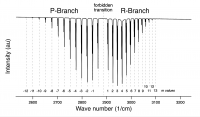Difference between revisions of "HCl Vibrational-Rotational Spectroscopy"
Jump to navigation
Jump to search
| Line 47: | Line 47: | ||
<div align="center"> ''ṽ = ṽ<sub>o</sub> + (2B<sub>e</sub> - 2 α<sub>e</sub>) m - α<sub>e</sub> m<sup>2</sup>, which has the form y = c + bx + ax<sup>2</sup>''</div> | <div align="center"> ''ṽ = ṽ<sub>o</sub> + (2B<sub>e</sub> - 2 α<sub>e</sub>) m - α<sub>e</sub> m<sup>2</sup>, which has the form y = c + bx + ax<sup>2</sup>''</div> | ||
'' | '' | ||
| − | :a = α<sub>e</sub> | + | :::a = α<sub>e</sub> |
| − | :b = 2B<sub>e</sub> - 2 α<sub>e</sub>'' | + | :::b = 2B<sub>e</sub> - 2 α<sub>e</sub>'' |
| − | :so you can solve for B<sub>e</sub>... | + | :::so you can solve for B<sub>e</sub>... |
| − | :and Be = [[File:Screen Shot 2020-03-26 at 9.36.14 AM.png|200px]] | + | :::and Be = [[File:Screen Shot 2020-03-26 at 9.36.14 AM.png|200px]] |
| + | :d) Now solve for the radius (r), the average internuclear separation of the H<sup>35</sup>Cl... | ||
| + | :e) repeat above for H<sup>37</sup>Cl. | ||
| + | |||
| + | ====Reduced mass calculations==== | ||
::https://en.wikipedia.org/wiki/Isotopes_of_chlorine | ::https://en.wikipedia.org/wiki/Isotopes_of_chlorine | ||
| Line 66: | Line 70: | ||
::::conversion factor: 1.66054e-27 kg/amu | ::::conversion factor: 1.66054e-27 kg/amu | ||
| − | |||
| − | |||
| − | |||
| − | |||
| − | |||
| − | |||
Revision as of 14:40, 26 March 2020
Adapted from Experiment #38 (Shoemaker, Garland, Nibler, 1989)
See Chapter 8 (Engel), more will be presented in lecture...
Sample Preparation
- a) Pull the HCl (g) off the headspace of a bottle of concentrated HCl using a 60 mL syringe.
- b) deliver the HCl (g) to the gas-sampling IR cell.
IR Gas-Phase Data Collection
- a) Collect data using the highest resolution.
- b) average 32 scans (both background and sample)
- c) Save-As...
- (A complete set of data can be found here.)
Spectral Analysis
- a) load IR data into Igor or Excel.
- b) Use the cursor tool to tabulate the H35Cl and H37Cl data into separate columns,
- c) Assign an "m-value" to each transition (note the 'm=0' forbidden transition) with the help of the following graphic (click to make bigger).

Data Analysis
Okay, so you should now have a table, probably in Excel but if you know how to do it in Igor then great (Igor does not offer any advantages here) with heading like this:
| m-value | H35Cl | H37Cl |
| -12 | XXXX | YYYY |
| -11 | XXXX | YYYY |
| -10 | XXXX | YYYY |
| -9 | XXXX | YYYY |
| ... | ... | ... |
| +1 | XXXX | YYYY |
| +12 | XXXX | YYYY |
| +13 | XXXX | YYYY |
- a) Make a plot, m-value verses freq (in 1/cm) for H35Cl data; this will NOT be a straight line but a polynomial curve.
- b) fit a second order polynomial to this data... ie y= ax2 + bx +c, and note the values for a, b, and c in your notes (lab notebook preferred).
- c) During our last lab period you were given a Shoemaker, et al. handout (???) that discussed this lab activity. Eq. 9 was:
ṽ = ṽo + (2Be - 2 αe) m - αe m2, which has the form y = c + bx + ax2
- a = αe
- b = 2Be - 2 αe
- so you can solve for Be...
- d) Now solve for the radius (r), the average internuclear separation of the H35Cl...
- e) repeat above for H37Cl.
Reduced mass calculations
- Reduced mass, "mu" = (m1*m2)/(m1+m2)
- 1H 1.007825 amu (99.9885%)
- 35Cl 34.968853 amu (75.78%)
- 37Cl 36.965903 amu (24.22%)
- conversion factor: 1.66054e-27 kg/amu
